service CADILLAC DEVILLE 1993 7.G Owner's Guide
[x] Cancel search | Manufacturer: CADILLAC, Model Year: 1993, Model line: DEVILLE, Model: CADILLAC DEVILLE 1993 7.GPages: 406, PDF Size: 20.78 MB
Page 252 of 406
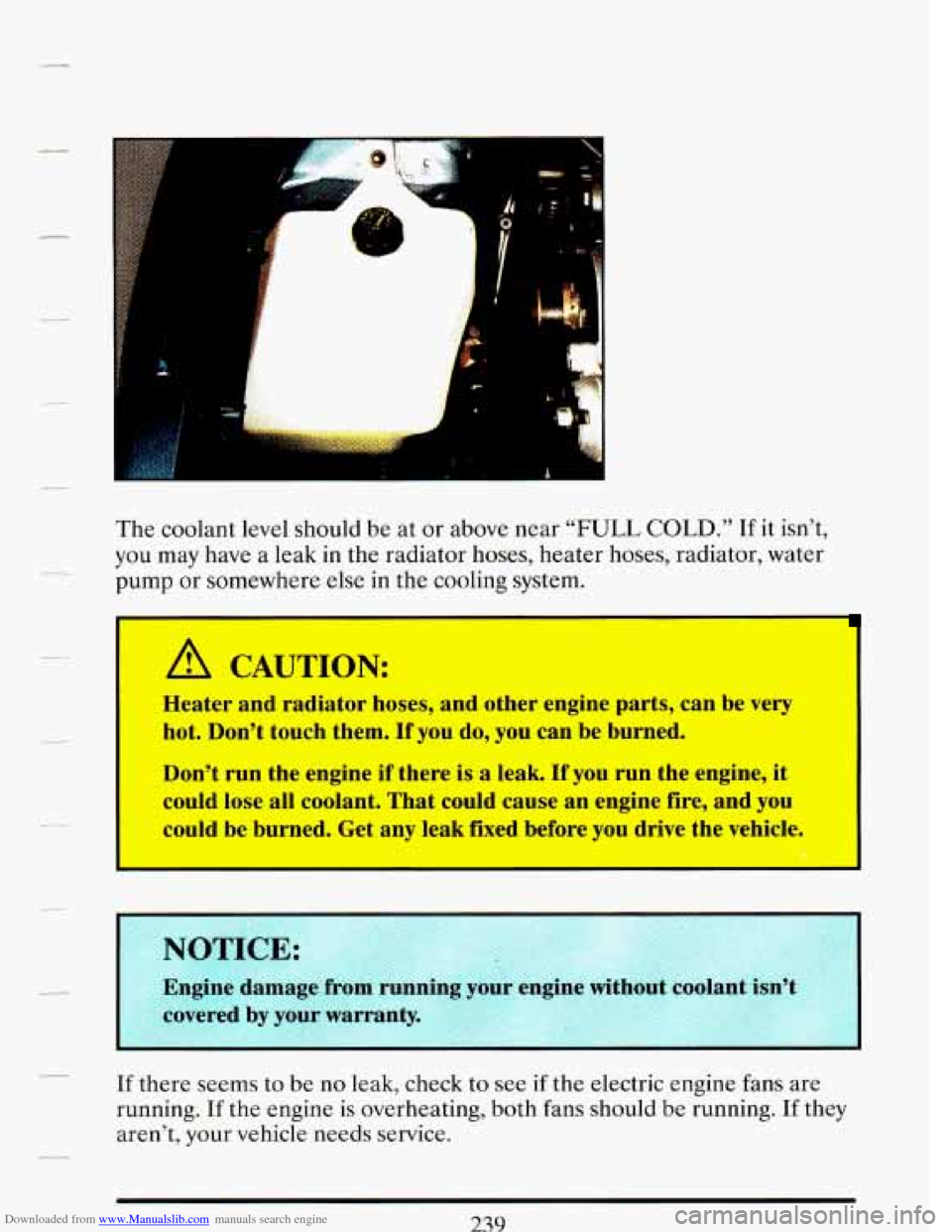
Downloaded from www.Manualslib.com manuals search engine The coolant level should be at or above near “FULL COLD.” If it isn’t,
you may have
a leak in the radiator hoses, heater hoses, radiator, water
pump or somewhere else in the cooling system.
A CAUTION:
Heater and radiator hoses, and other engine parts, can be very
hot. Don’t touch them. If you do, you can be burned.
Dodbrun the engine if there is a leak. If you run the engine, it
could lose all coolant. That could cause an engine fire, and you
could be burned. Get any leak Pied before you drive the vehicle.
ng your engine witrwut coularr~ isn’t
If there seems to be no leak, check to see if the electric engine fans are
running.
If the engine is overheating, both fans should be running. If they
aren’t, your vehicle needs service.
239
Page 273 of 406
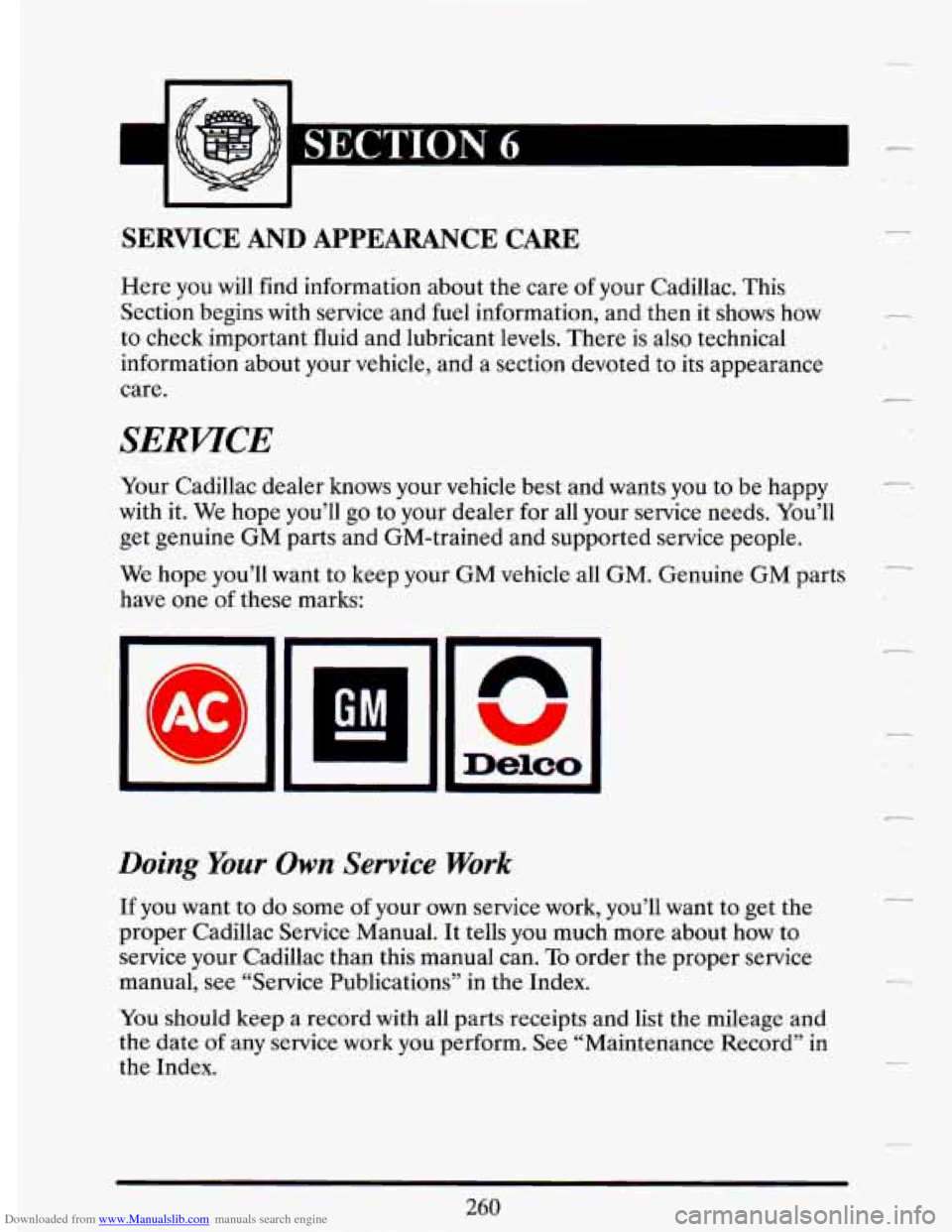
Downloaded from www.Manualslib.com manuals search engine SERVICE AND APPEARANCE CARE
Here you will find information about the care of your Cadillac. This
Section begins
with service and fuel information, and then it shows how
to check important fluid and lubricant levels. There is also technical
information about your vehicle, and a section devoted
to its appearance
care.
SERWCE
Your Cadillac dealer knows your vehicle best and wants you to be happy
with it. We hope you’ll go to your dealer for all your service needs. You’ll
get genuine GM parts and GM-trained and supported service people.
We hope you’ll want to keep your GM vehicle all GM. Genuine GM parts
have one
of these marks:
~ Deleo
L
Doing Your Own Service Work
If you want to do some of your own service wax, you’ll want to get the
proper Cadillac Service Manual. It tells you much more about how to
service your Cadillac than this manual can.
To order the proper service
manual, see “Service Publications” in the Index.
You should keep a record with all parts receipts and list the mileage and
the date
of any service work you perform. See “Maintenance Record” in
the Index.
.-
--
”.,
Page 274 of 406
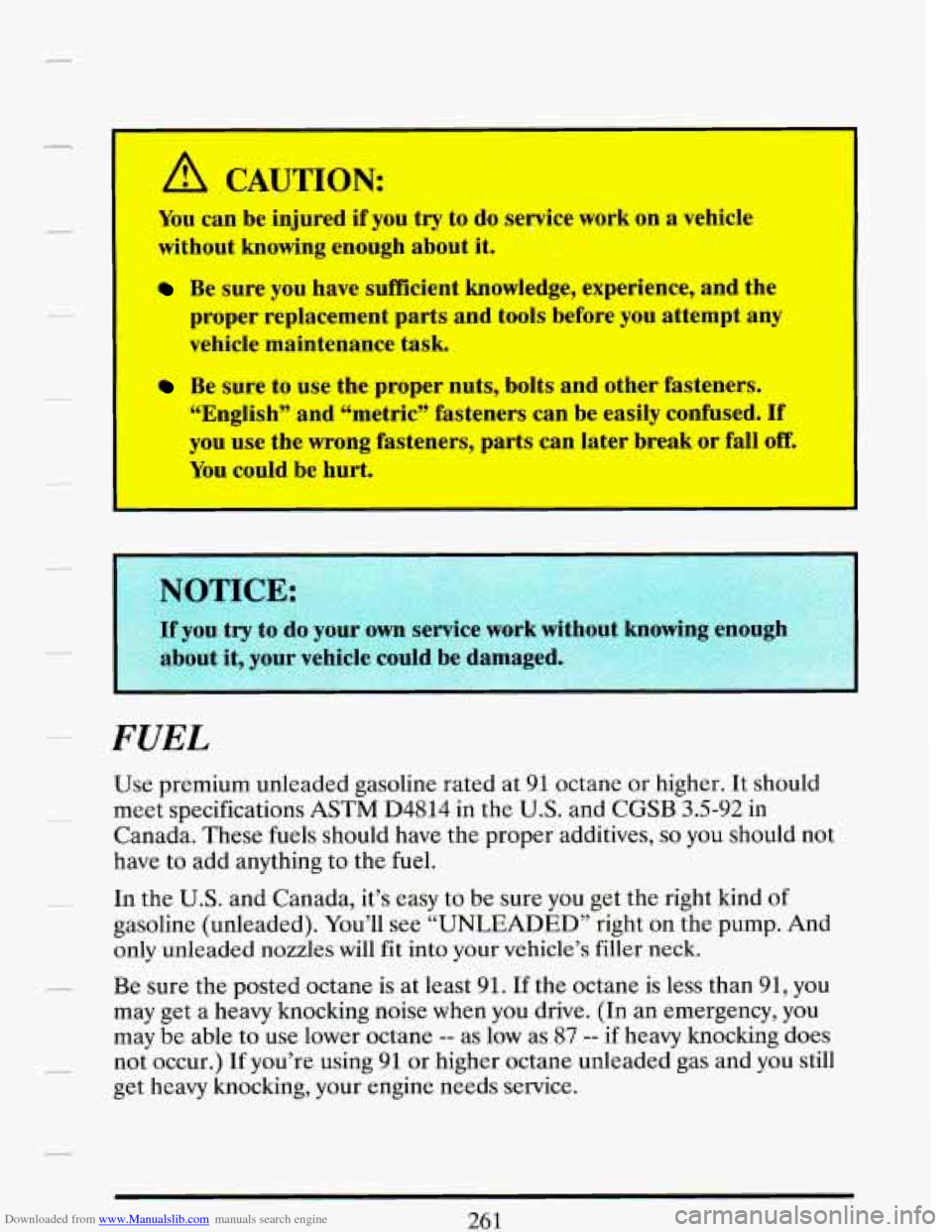
Downloaded from www.Manualslib.com manuals search engine I
A CAUTION:
You can be injured if you try to do service work on a vehicle
without knowing enough about it.
Be sure you have sufficient knowledge, experience, and the
proper replacement parts and tools before you attempt any
vehicle maintenance task.
Be sure to use the proper nuts, bolts and other fasteners.
“English” and “metric” fasteners can be easily confused.
If
you use the wrong fasteners, parts can later break or fall off.
You could be hurt.
FUEL
Use premium unleaded gasoline rated at 91 octane or higher. It should
meet specifications ASTM
D4814 in the US. and CGSB 3.5-92 in
Canada. These fuels should have the proper additives,
so you should not
have to add anything to the fuel.
In the
U.S. and Canada, it’s easy to be sure you get the right kind of
gasoline (unleaded). You’ll see “UNLEADED” right on the pump. And
only unleaded nozzles will fit into your vehicle’s filler neck.
Be sure the posted octane is at least 91.
If the octane is less than 91, you
may get a heavy knocking noise when you drive.
(In an emergency, you
may be able
to use lower octane -- as low as 87 -- if heavy knocking does
not occur.)
If you’re using 91 or higher octane unleaded gas and you still
get heavy knocking, your engine needs service.
261
Page 275 of 406

Downloaded from www.Manualslib.com manuals search engine What about gasoline with blending materials that contain oxygen, such as
MTBE or alcohol?
MTBE is “methyl tertiary-butyl ether.” Fuel that is
no more than 15%
MTBE is fine for your car.
Ethanol is ethyl or grain alcohol. Properly-blended fuel that is no more
than
10% ethanol is fine for your car.
Methanol is methyl or wood alcohol.
Gasolines for Cleaner
Air
Your use of gasoline with detergent additives will help prevent deposits
from forming in your engine and fuel system. That helps keep
your
engine in tune and your emission control system working properly. It’s
good for your vehicle, and you’ll be doing your part for cleaner air.
Many gasolines are
now blended with materials called oxygenates.
General Motors recommends that you use gasolines with these blending
materials, such as
MTBE and ethanol. By doing so, you can help clean
the air, especially in those parts of the country that have high carbon
monoxide levels.
In addition, some gasoline suppliers are now producing reformulated
gasolines. These gasolines are specially designed to reduce vehicle
emissions. General Motors recommends that you use reformulated
gasoline.
By doing so, you can help clean the air, especially in those parts
of the country that have high ozone levels.
You should ask your service station operators if their gasolines contain
detergents and oxygenates, and if they have been reformulated to reduce
vehicle emissions.
r
L
.-.
262
Page 286 of 406

Downloaded from www.Manualslib.com manuals search engine How To Reset the Oil Life Indicator: After the oil has been changed,
press and hold the
“RANGE” and “RESET” buttons between 5 and 60
seconds. Once the buttons are released the “CHANGE OIL SOON”
light will flash 4 times to indicate it has reset to 100. If the “CHANGE
OIL SOON” light comes on for 5 seconds it did not reset. You will need
to reset the system again. The percentage
of oil life remaining may be
checked at any time by pressing the
“RANGE” and “FUEL USED” on
the Fuel Data center.
Engine Block Heater: An engine block heater can be a big help if you
have to park outside
in very cold weather, O°F (-18OC) or colder. If your
vehicle has this option, see “Engine Block Heater” in the Index.
What to Do with Used Oil:
’
A CAUTION:
Used engine oil contains things that have caused skin cancer in
laboratory animals. Don’t let used oil stay
on your skin for very
long. Clean your skin and nails with soap and water, or a good
hand cleaner. Wash or properly throw away clothing or rags
containing used engine oil.
Used oil can be a real threat to the environment. If you change your own
oil, be sure to drain all free-flowing oil from the filter before disposal.
Don’t ever dispose
of oil by pouring it on the ground, into sewers, or into
streams or bodies
of water. Instead, recycle it by taking it to a place that
collects used oil.
If you have a problem properly disposing of your used
oil, ask your dealer, a service station or
a local recycling center for help.
Page 287 of 406

Downloaded from www.Manualslib.com manuals search engine AIR CLEANER
To gain access to the
air cleaner element,
loosen the four screws
and lift the
top half of
the air cleaner
assembly.
Refer
to the
. 1 Maintenance Schedule
to determine when to
replace the air filter.
See “Scheduled Maintenance Services”
in the Index.
A CAUTION:
Operating the engine with the air cleaner off can cause you or
others to be burned. The air cleaner not only cleans the air, it
stops flame
if the engine backfires. If it isn’t there, and the
engine backfires, you could be burned. Don’t drive with it
off
-nd bc ---?ful workin- 3n the engine with the sir cleaner A
If the air cleaner OII, a loackfire can caur - a damae g enginc
fire. And, dirt can easily get into your engine,
which mil damag
it. Always have the air cleaner in place when you’re driving.
1
Page 288 of 406
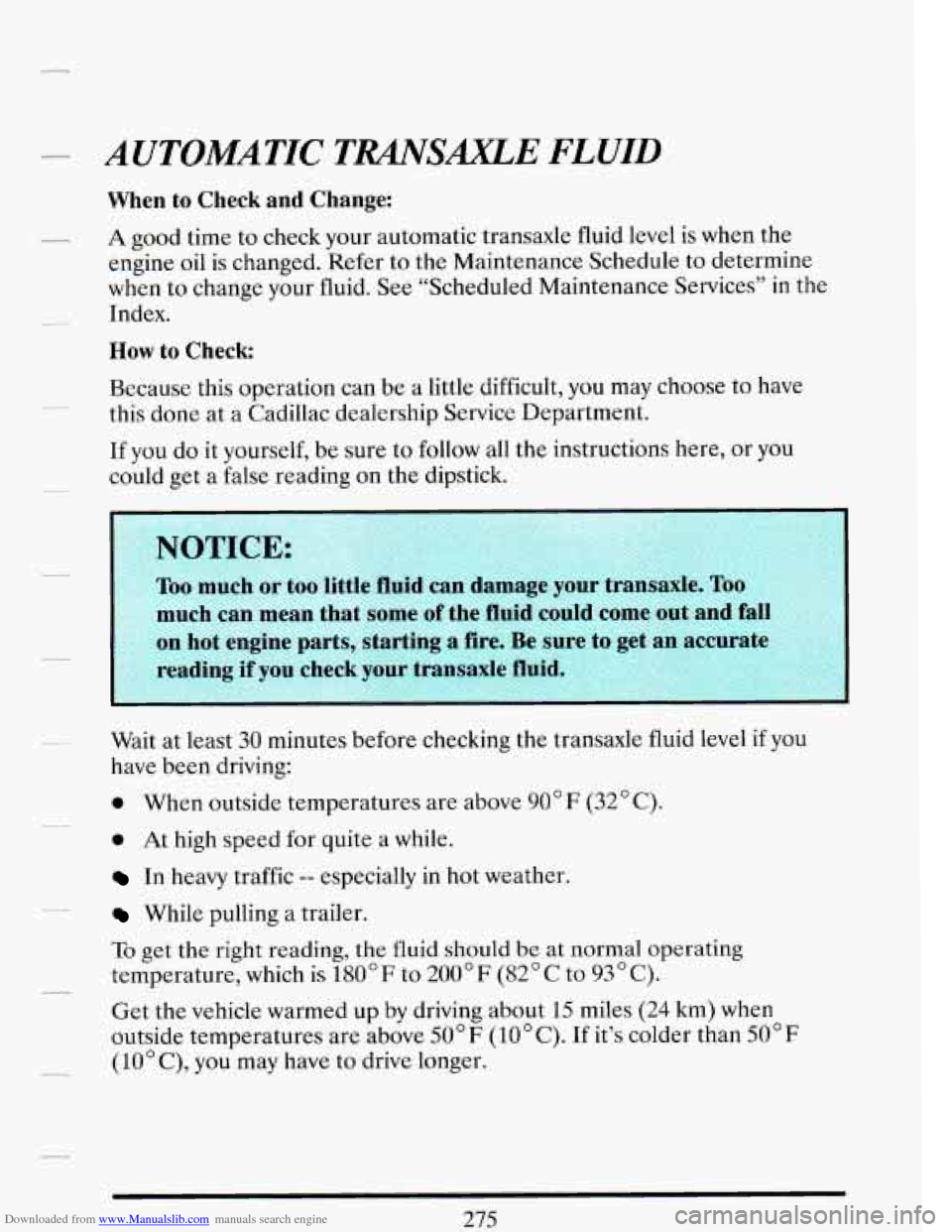
Downloaded from www.Manualslib.com manuals search engine AUTOMATIC TRAS.E FLUID
When to Check and Change:
A good time to check your automatic transaxle fluid level is when the
engine oil is changed. Refer to the Maintenance Schedule to determine
when to change your fluid. See "Scheduled Maintenance Services"
in the
Index.
How to Check
Because this operation can be a little difficult, you may choose to have
this done
at a Cadillac dealership Service Department.
If you do it yourself, be sure to follow all the instructions here, or you
could get a false reading on the dipstick.
Wait at least
30 minutes before checking the transaxle fluid level if you
have been driving:
0 When outside temperatures are above 90" F (32°C).
0 At high speed for quite a while.
In heavy traffic -- especially in hot weather.
While pulling a trailer.
To get the right reading, the fluid should be at normal operating
temperature, which is
180°F to 200" F (82 " C to 93 " C).
Get the vehicle warmed up by driving about 15 miles (24 km) when
outside temperatures are above
50°F (10°C). If it's colder than 50°F
(10" C), you may have to drive longer.
275
Page 321 of 406
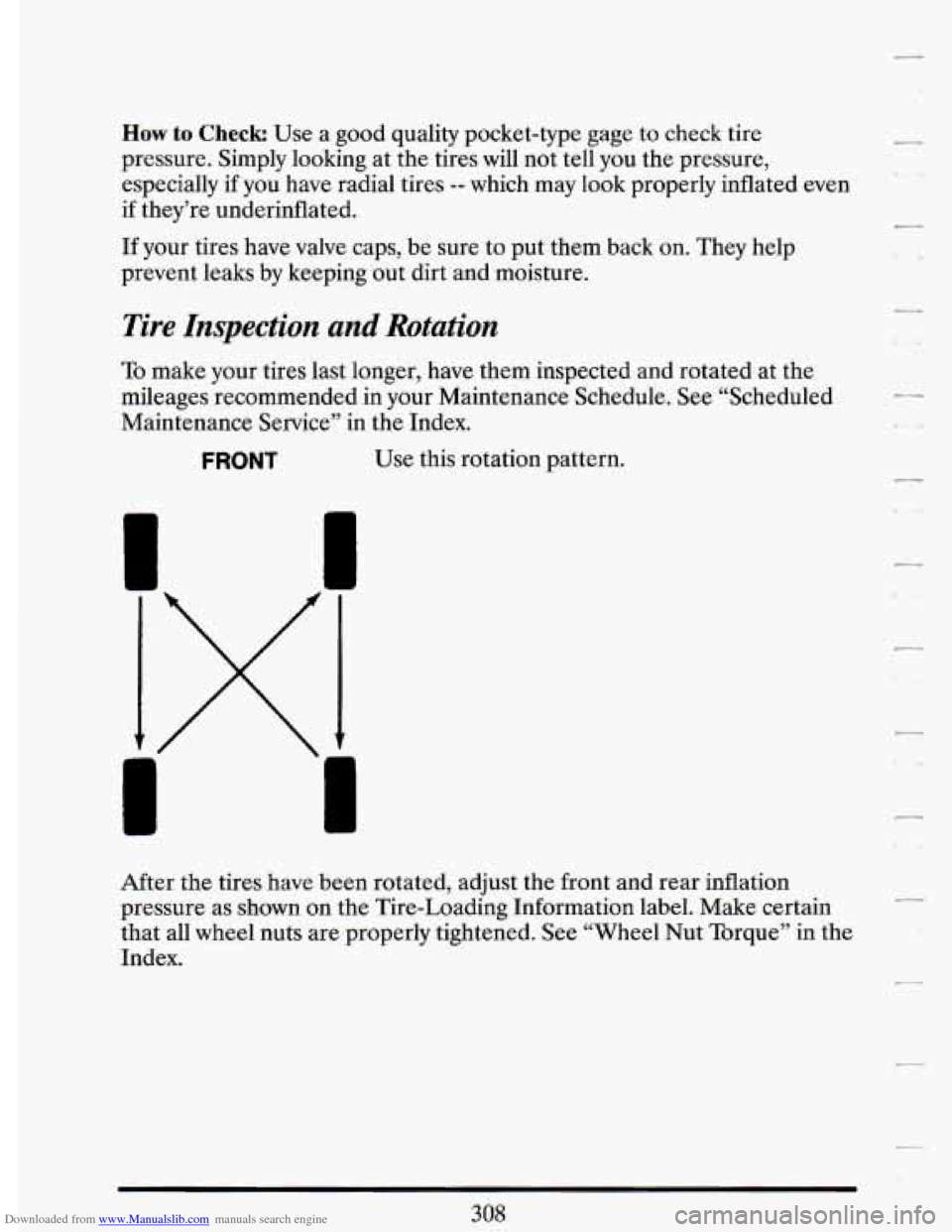
Downloaded from www.Manualslib.com manuals search engine How to Check Use a good quality pocket-type gage to check tire
pressure. Simply looking at the tires will not tell you the pressure,
especially if you have radial tires
-- which may look properly inflated even
if they’re underinflated.
If your tires have valve caps, be sure to put them back on. They help
prevent leaks by keeping out dirt and moisture.
Tire Inspection and Rotation
To make your tires last longer, have them inspected and rotated at the
mileages recommended in your Maintenance Schedule. See “Scheduled Maintenance Service” in the Index.
FRONT Use this rotation pattern.
After the tires have been rotated, adjust the front and rear inflation
pressure as shown on the Tire-Loading Information label. Make certain
that all wheel nuts are properly tightened.
See “Wheel Nut Torque” in the
Index.
Page 323 of 406
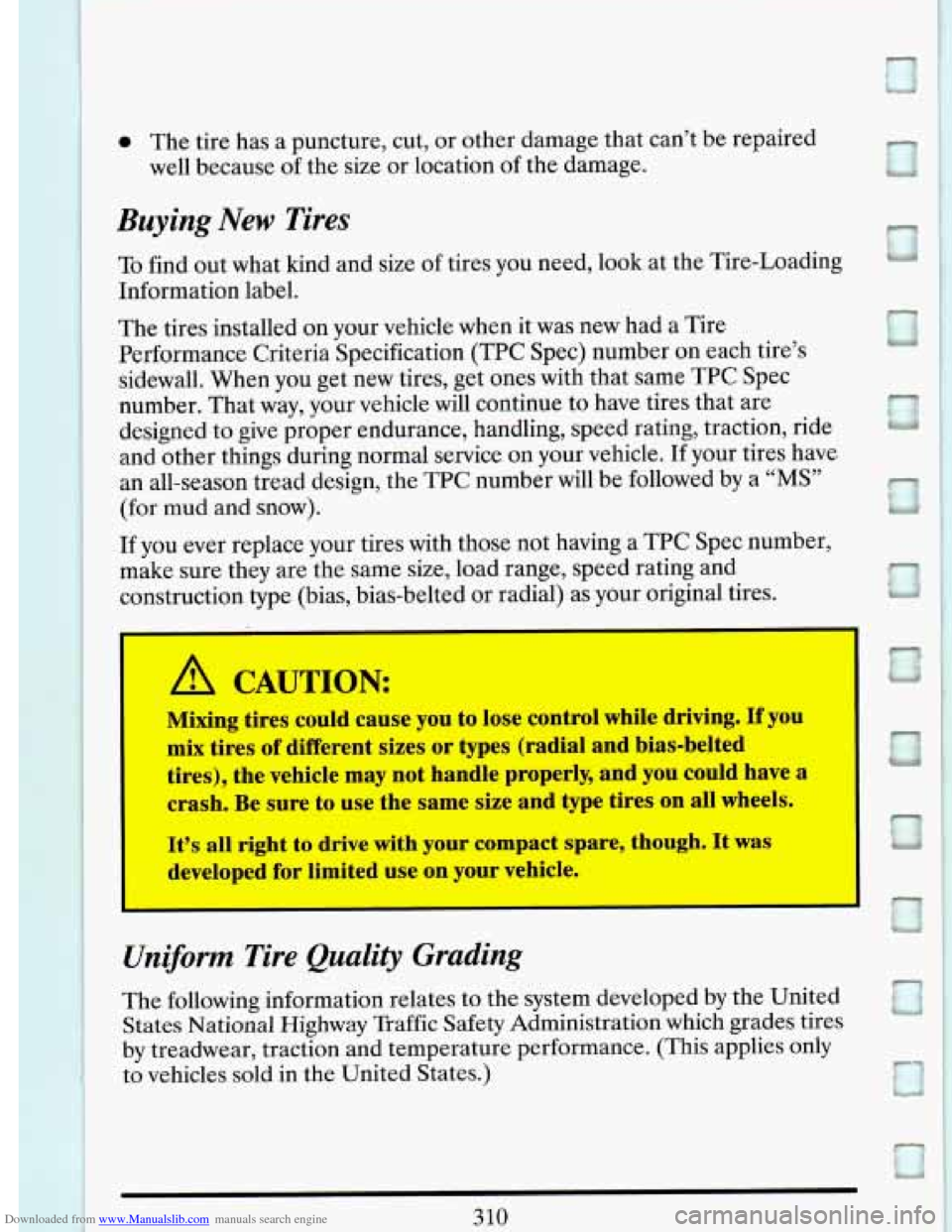
Downloaded from www.Manualslib.com manuals search engine 0 The tire has a puncture, cut, or other damage that can’t be repaired
well because of the size or location of the damage.
Buying New Tires
To find out what kind and size of tires you need, look at the Tire-Loading
Information label.
The tires installed on your vehicle when it was new had a Tire
Performance Criteria Specification (TPC Spec) number on each tire’s
sidewall. When you get new tires, get ones with that same TPC Spec
number. That way, your vehicle will continue to have tires that are
designed to give proper endurance, handling, speed rating, traction, ride
and other things during normal service on your vehicle.
If your tires have
an all-season tread design, the TPC number will be followed by a
“MS”
(for mud and snow).
If you ever replace your tires with those not having a TPC Spec number,
make sure they are the same size, load range, speed rating and
construction type (bias, bias-belted or radial) as your original tires.
I
Mixing tires could cause you to lose control while driving. If you
mix tires of different sizes or types (radial and bias-belted
tires), the vehicle may not handle properly, and you could have a
crash. Be sure to use the same size and type tires on all wheels.
It’s all right tlol drive with your compact spare, though. It was
developed for limited use on your vehicIe.
Uniform Tire Quality Grading
The following information relates to the system developed by the United
States National Highway Traffic Safety Administration which grades tires
by treadwear, traction and temperature performance. (This applies only
to vehicles sold in the United States.)
I 310
Page 324 of 406

Downloaded from www.Manualslib.com manuals search engine Treadwear
The treadwear grade is a comparative rating based on the wear rate of
the tire when tested under controlled conditions on a specified
government test course. For example, a tire graded
150 would wear one
and a half
(1 112) times as well on the government course as a tire graded
100. The relative performance of tires depends upon the actual
conditions
of their use, however, and may depart significantly from the
norm due to variations in driving habits, service practices and differences
in road characteristics and climate.
Traction - A, B, C
The traction grades, from highest to lowest are: A, B, and C. They
represent the tire’s ability to stop on wet pavement as measured under
controlled conditions on specified government test surfaces
of asphalt
and concrete.
A tire marked C may have poor traction performance.
Warning: The traction grade assigned to this tire
is based on braking
(straight-ahead) traction tests and does not include cornering (turning)
traction.
Temperature - A, B, C
The temperature grades are A (the highest), B, and C, representing the
tire’s resistance to the generation
of heat and its ability to dissipate heat
when tested under controlled conditions on a specified indoor laboratory
test wheel. Sustained high temperature can cause the material of the tire
to degenerate and reduce tire life, and excessive temperature can lead to
sudden tire failure.
The grade C corresponds to a level of performance
which all passenger car tires must meet under the Federal Motor Vehicle
Safety Standard
No. 109. Grades B and A represent higher levels of
performance on the laboratory test wheel than the minimum required by
law.
Warning:
The temperature grade for this tire is established for a tire that
is properly inflated and not overloaded. Excessive speed, underinflation,
or excessive loading, either separately or in combination, can cause heat
buildup and possible tire failure.
Those grades are molded on the sidewalls
of passenger car tires.
311